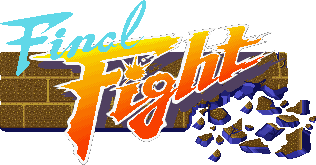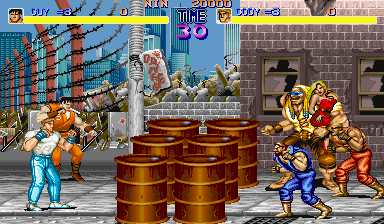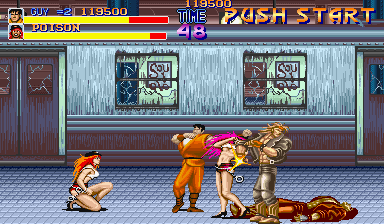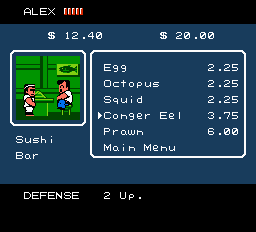
1989: Beat-em-ups
originally written December 17, 2009 / Last edited August 8, 2020

While Konami was a well-established company with many hits under its belt by 1989, Capcom was a successful publisher that was just starting to truly find itself. Its early days were mostly filled with a wide variety of games. While their early games were well-made, some of their early side-scrollers are infamous for difficulty that bordered or crossed the line of being cheap and quarter-devouring. Games like Trojan were filled with great ideas, but their later levels felt more like an arcade donation collection box by killing you as often as possible with little joy to be found in-between the inserted coins. That's fine for the kind of gamer who fiends for extreme difficulty, but it's a turn-off nearly everyone else. Along with making more balanced ports of these games on the NES and Famicom, they were crafting new, original console games with this same sense of great game mechanics with more inviting difficulty ramps. That new line of thought seems to have influenced the arcade division and led to better hits in the late '80s, including 1988's Forgotten Worlds, 1989's Strider and their 1989 smash hit that helped revolutionize beat-em-ups forever.

Final Fight's biggest legacy is probably it's basic, simple and precise controls. Double Dragon may have a richer move set and superior double team methods, but some controller motions could lead to accidental attacks that leave you wide open to being attacked yourself. Final Fight has one attack button to tap out fighting combos that finish with a knockdown move and one button lets you jump. Pressing attack during a straight vertical jump leads to a mid-air attack but pressing attack during a forward jump lead to a forward jump attack that was perfect for knocking down large clusters of bad guys. A bonus move is that holding DOWN while pressing the attack button during a jump performs a downward attack that hurts and stuns the opponent long enough to either attack or grapple the enemy. The grappling system is also rewarding, since thrown enemies can hit other enemies. One major contribution was the Sure Kill Technique, which allowed players to attack all nearby enemies at once at the cost of some health. Not only did these costly moves help clear out a swarm of drones, these attacks also looked really damned cool in a way that was usually reserved for video game bosses. Finally, the player could be cheap too! Final Fight may not have invented every single thing on this list, but it boiled all of these great elements into a recipe that has been co-opted to the point of becoming default features of the genre, much like how many Super Mario techniques just became standards of platform gaming. Re-use of the formula wasn't always from laziness as much as it was using a great set of controls that was easy to pick up, had little-to-zero control cross conflicts in and had nearly everything you could want in a brawler. The fact that this became the default control set-up for a good beat-em-up is a testament to Okamoto's original plan.

Of course, the fine folks at Technos weren't just sitting around watching the asphalt grow after putting two-player street warfare on the map with Double Dragon. The Lee brothers weren't just out for revenge in Double Dragon II, mainly a repeat of the first game with some very solid improvements, they were also conquering the home market in various console versions of their first two adventures. Those ports featured differences that expanded the original games and arguably created a more fun experience for the home versions. Meanwhile, Kunio-kun and the other hot-blooded students from Nekketsu Koha Kunio-kun (localized outside Japan as Renegade) stepped off the streets for a legendary unfriendly game of Super Dodge Ball in 1987. By the time 1989 rolled around, the streets called them home and the violence began again.


In 1989's Downtown Nekketsu Monogatari, Kunio teams with his rival Riki to rescue Riki's girlfriend who has been kidnapped by a gang leader. The game was localized for the U.S. by Technos itself as River City Ransom (missing 1989 by a whole month). The Japanese high-school uniforms were replaced with jeans and t-shirts and the heroes were re-named Alex and Ryan. Most of the game's basics still remain the same, including the mission to rescue a girl from a gang leader. I know that's the plot of nearly every beat-em-up ever made but Technos put all the innovation where it really counts: the game itself.
Each player has a set of stat attributes for everything from speed and stamina to punch and kick power. When the game starts, the stats are just high enough to fight off the early enemies who spout unforgettable dialogue and drop money when they're defeated. The typical 'levels with invisible boundaries' format is replaced with a series of areas connected by paths, doors, stairs and sides of the screen. Some of those areas are shopping centers where you can use the money taken from your beaten enemies to buy items in the various stores. Items can do everything from regain health, improve your stats and teach you new moves. You even have the option of dining in restaurants or buying take-out food that you can chow down in the midst of battle when your health is getting low. Every shop is unique in both name, inventory and charm. As you build up your hero like an RPG character, you're also tracking down info on your enemies and some must be hunted down before you can continue. With things like this, the enemy character dialogue and the surprisingly crafty enemy A.I. that made even the drones smart enough to run off and get reinforcements or grab weapons if they were getting their butts kicked, River City Ransom was impressive on every level. There are modern sandbox/open world games you've played where many of the enemies don't have the half the brains of the gangs seen in this NES cart. That's either some unique form of street smarts found only in the public school system or this world just doesn't how to make a halfway decent thug anymore. You know those weapons I mentioned earlier? You can carry them from level to level without being forced to drop it. That's right. A careful player could beat all the game's bosses into submission with the same spare tire if they really cared enough. River City Ransom represents a missed opportunity for the walk-and-brawl genre to level-up. No, every beat-em-up doesn't need stat-building, shop systems or even the open area gameplay, but there's no reason why Mike Haggar, Axel Stone, Billy Lee, Rick Norton and every other beat-em-up character had to keep dropping weapons to move to the next scene while fighting on systems with far more power than the NES. In their own way, it took sandbox-style action games like Grand Theft Auto to bring back that River City feeling even if it's on the wrong side of the law. I don't know if those developers were R.C.R. fans but it wouldn't be a shock.Honestly, River City Ransom has to be considered the ultra lord king supreme of cult classic video games. It wasn't a game that most of your friends even heard of much less played. Running into another RCR fan was like talking to a horror fan about Phantasm movies or Hip-Hop junkies who liked Ultramagnetic MC's. Why? Well, most reports say that the U.S. version of the game was very hard to find. Technos wasn't a really big company in the United States, so I guess the game didn't have as big of a print run as many other games. In fact, I never saw the game on a store shelf until Splitstone Electronics had it in 2004. That's right. 2004. It was rare in this area and most of the people I know who played it when it was new did so by renting it. I'm pretty sure I rented it more times than I've rented any other game or movie period. It was just that great little game with a growing word-of-mouth reputation that got even bigger thanks to the internet, where even the Japanese Kunio-Kun games can get love and respect from English speaking fans. This led to the successful 2012 Kickstarter campaign to fund an official River City Ransom follow-up to be created by Conatus Creative, a crew staffed by fellow fans.
So there you have it. These weren't just some of the best examples of the genre of the year but some of the best of all time. Teenage Mutant Ninja Turtles, Final Fight and River City Ransom/Downtown Nekketsu Monogatari each played a part in improving the beat-em-up style of gameplay in ways that we now take for granted. By coincidence, by mutual influence or by fate itself, they all just happened to be released in 1989, the greatest year in video games.
Return to top of the top of the page





